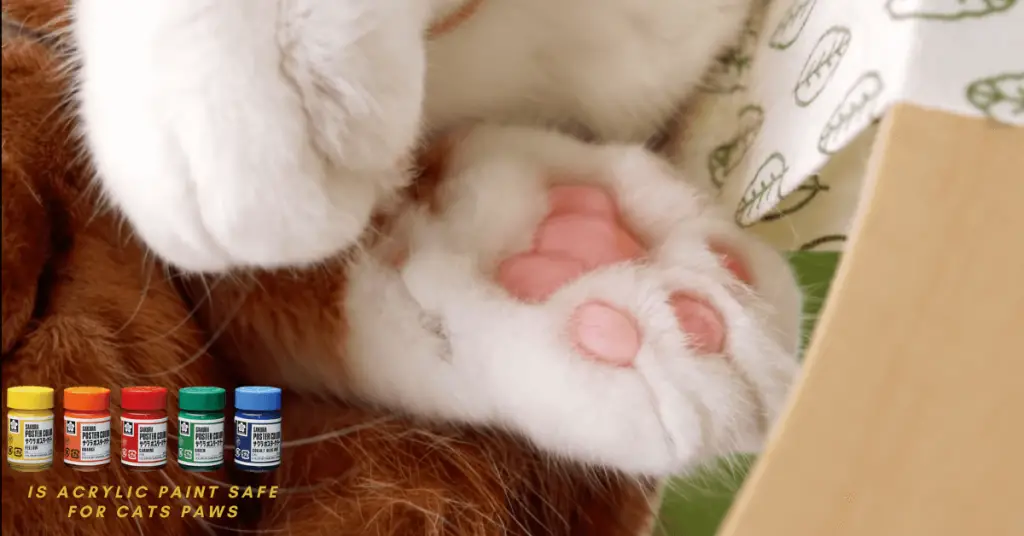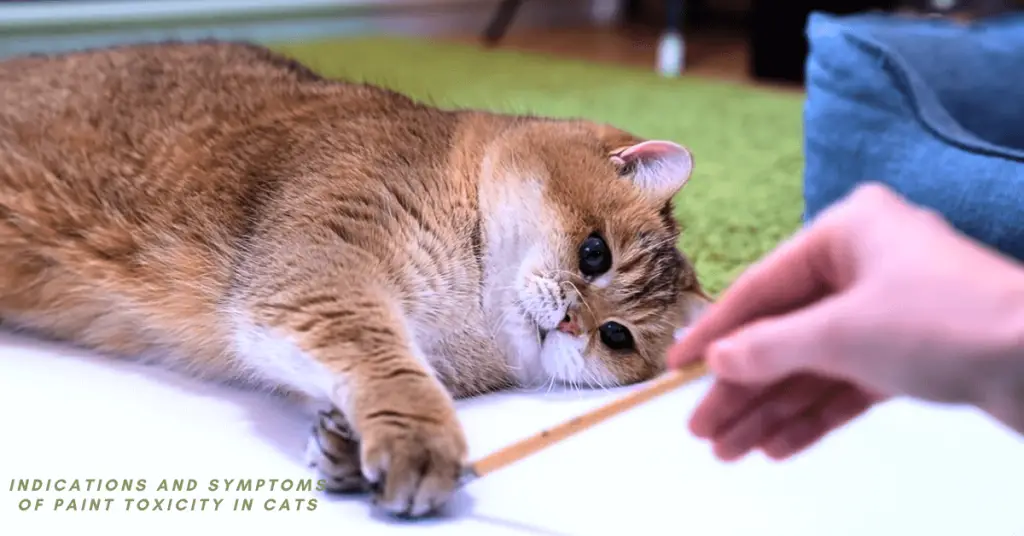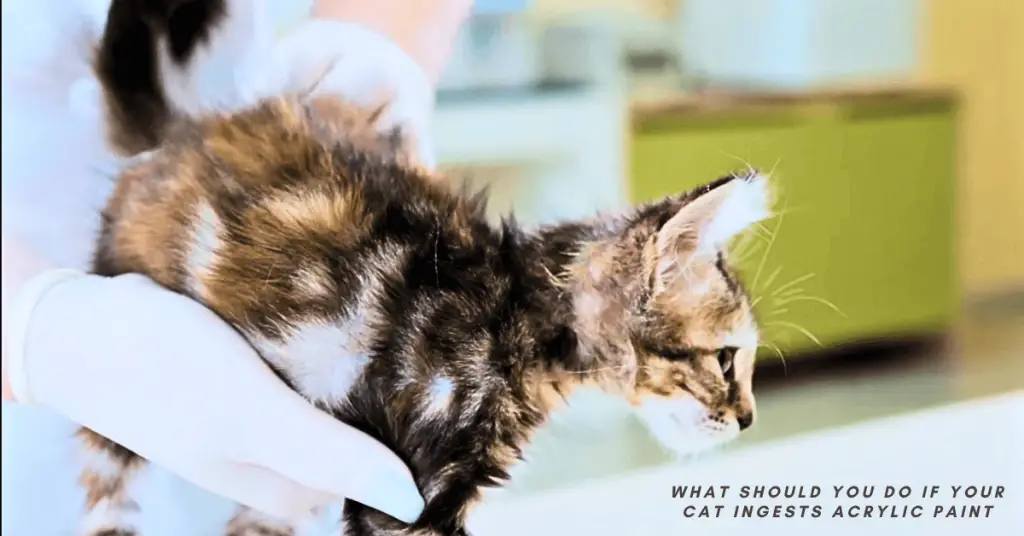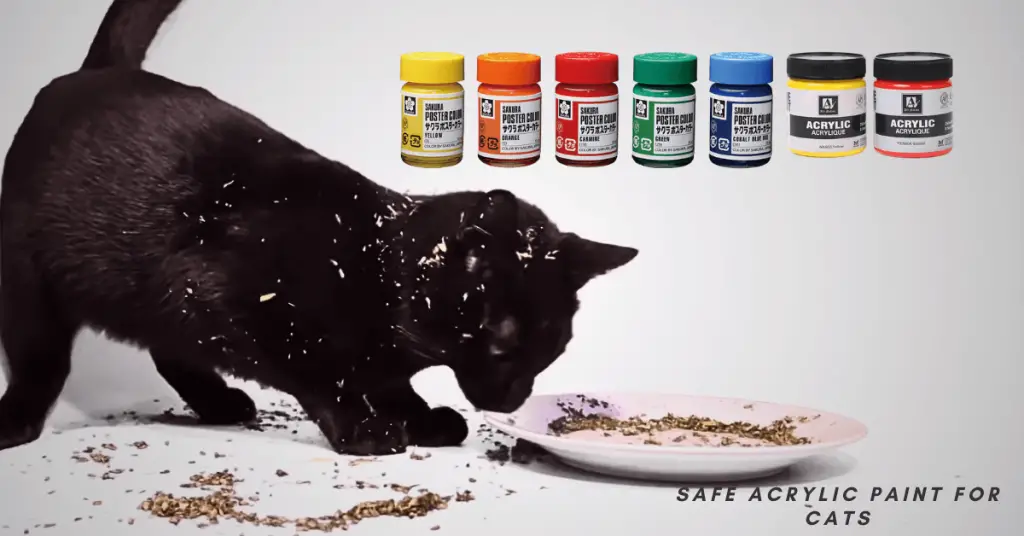Most pet owners are careful about their pet’s health more than their art; it’s good. Acrylics somehow have the same effect on animals as well as human health. Generally, acrylic paints are not toxic, but ingesting them in higher quantities may bring serious health concerns to your pet.
Here in the article below, we’ll talk about some health effects of acrylic paint on your cat and other pets. In addition, we’ll give instructions on how to treat a cat in case of poisoning due to the ingestion of acrylics.
Is Acrylic Paint Toxic to Cats?
While acrylic paint is usually not highly toxic to cats, it’s still advised to prevent your cat from ingesting or coming into contact with wet or uncured paint. The main concern with acrylic paint is its potential to cause gastrointestinal upset if ingested in large quantities.
The paint contains chemicals, pigments, and additives that can be harmful if consumed in significant amounts. Additionally, some cats may experience skin irritation or allergic reactions if they come into contact with wet paint.
Is Acrylic Paint Toxic to Pets?
Usually, acrylic paint is harmless to pets as it has non-toxic compounds in its composition. Volatile organic compounds, like oil-based paints, are replaced with water in acrylics. So there’s no worry about being around your pet while painting. But be careful not to spill the paint on your pet’s fur, as it can be difficult to remove.
However, ingestion of the paint may bring consequences like gut, liver, and heart problems. The paint can seriously affect the body and lead to vomiting, abdominal pain, liver damage, diarrhea, and sometimes dehydration. So keep an eye on your pet while being busy drawing and painting.

Is Acrylic Paint Safe For Cats Paws?
Acrylic paint is only toxic when it makes its way to the mouth, eyes, nose, and other body parts. So it’s safe if your cat walks on the paint. But definitely, you’ll not wish your cat’s paws to be stained. So better to wash away the paint immediately from the feet with good quality soap and water.
Moreover, we should be aware of the cat’s habits. She licks her paws most of the time, and it can be dangerous as the paint may get into the mouth of your cat. If it happens, you must call a veterinarian to rescue her.

Indications and Symptoms of Paint Toxicity in Cats:
Cats are one of the vastly liked pets around the globe. They are famous for being curious and careless animals. They consume most of their time sleeping and examining.
They try to intrude on your work. And if you’re a painter, they’ll definitely not step back and meddle in your paint job. It’s pretty funny and concerning at the same time.
If your cat ingests the paint, what will be the result, and how should you tackle the situation? Paint toxicity can cause gut and liver problems in your cat.
So, first, you must diagnose and look for the symptoms to determine if your cat licked the paint when you were not around. If you see your feline friend showing the following signs, don’t be late to rescue her.
- The most common and primary symptoms are vomiting, and frequent diarrhea, which shows your cat has ingested the paint lately.
- Secondary symptoms include lower abdominal pain, upset stomach, discoloured stool, and loss of appetite.
- You may also find out your cat is not interested in routine activities. In addition, she seems tired and sick.
- If the paint toxicity makes its way to the liver, which is the main organ, the cat may die.
So, if you notice your cat experiencing any symptoms discussed, you should take her to the veterinarian and pursue quick medical aid. Being careless in your pet’s matter can be regretful.

What Should You Do If Your Cat Ingests Acrylic Paint?
The foremost thing you should do is keep your cat from licking the acrylic paints. But if she ingests the paint by mistake, you should contact a veterinarian immediately to rescue her. Consult the veterinarian and take prompt steps to seek medical help.
It’s not necessary to ingest the paint is always toxic; sometimes, the cat recovers itself, but you must not be careless and take crucial steps to avoid any mischief. Much of the time, the cat seems to be normal, but the paint can be proved deadly gradually. So, better to take the steps below as an initial treatment for your cat.
- Calm your cat and make her take rest, as too much physical activity can cause the paint to spread through the body due to higher blood pressure.
- One way is to give your cat something to drink, like milk or simply water. It may help flush the toxic chemicals out of the body.
- Stand by your cat when she goes to pee. If you feel the paint is excreting along with the stool, it’s a good sign.

When Are Acrylic Paints Not Safe For Cats?
Acrylic paints are safe as long as they are not ingested or taken into the eyes, nose, and ears. The paint is harmful in the following situations for you as well as your cat.
Airbrushing:
Airbrushing is a common technique, also called air spray paint, used to paint surfaces using compressed air mixed with paint. While painting using this method, you have to be much more protected and follow preventive measures.
But how is paint toxic for cats while airbrushing? If your cat is wandering around, the paint in the air can make its way to the eyes and other exposed parts of your pet’s body. In addition, the fumes can be already inhaled, which can worsen the situation.
Sanding:
Sanding is another technique but with the same consequences as airbrushing. It also releases paint content into the air, which your cat can inhale.
It can use chest problems, coughing, sneezing, and most probably lead to infection. So be more careful and provide ventilation to your decorating location.
Safe Paint For Cats:
If you’re a painter and pet lover at the same time, you might be looking for paints that are harmless to cats and other animals. Because you can’t make your pets stay away all the time from your painting job, consider the points below before you purchase paints.
- First of all, read the label on the packing thoroughly and make sure you’re not buying toxic paint.
- Look for the ingredients in the paint. If you find them harmful to be used around your cat, skip the paint.
- Prefer paint composed of natural ingredients. They are safe for the human body as well as animals.
Safe Acrylic Paint For Cats:
Choosing safe acrylic paint cats should be done through the criteria below.
- First, the paint should not be toxic; you can find it labeled on the packaging.
- You must check for the list of contents in the paint composition.
- Be first on selecting the paint having natural ingredients as they are harmless to humans and animals. These kinds of acrylic paint can even be applied to the skin.
- Buy the paint from an authorised website or store so that the fake manufacturers do not deceive you.

Is Acrylic Paint Safe For Birds?
Acrylic paint is generally not harmful to birds, but it’s not safe either. Inhaling the paint fumes brings severe consequences to the lungs of your avian fellows.
So make sure to avoid painting or spraying while the birds are nearby. If you’re planning to give some splash of designs to the bird’s cage, bring the cage to a ventilated area first. Or you can empty the cage and transfer your avian friends to a new home for a few hours.
If you want to decorate bird shelters located at your home, read the blog: Is acrylic paint safe for birdhouses?
Is Acrylic Paint Toxic To Dogs?
Acrylic paint has the same effects on your dog’s health as it has on other animals like cats and birds. The paint fumes are the primary danger as they are easily available in the air and can be inhaled.
So, the best practice is putting your dog inside a room while you’re busy painting. Or you can select a largely ventilated location for your paint job. However, seeking medical assistance should not be delayed if your dog licked acrylic paint.
How to Remove Paint from Cat Fur? Useful Tips
If your cat has mistakenly gotten acrylic paint on her fur, it can be removed following the methods below.
- If the paint is still wet, talk some warm water and wash your cat’s fur thoroughly.
- If the paint is dried, it is a bit intricate to remove. But still possible with cat shampoo.
- Take half warm water and mix cat shampoo in it. Let your cat take a bath in the water.
- Rub the hair with your fingers and try to peel off the paint as much as possible.
- Rinse away the shampoo from the fur and recount the procedure three to four times.
- Once all the paint is washed away, take a towel and dry your cat’s fur.
FAQ’s
Is acrylic paint pet safe?
Yes, acrylic paint is harmless and safe for your pets. Some paints may have toxins, so better to read the label of the packaging. If it has non-toxic contents, it can be used around pets.
What paint is safe for cats?
The safest paint for cats is the one having slight or no toxic elements. Generally, acrylic paints are safe for cats if they are not composed of heavy or toxic metals. On the other hand, oil-based paints possess some hazards as they contain chromium oxide along with zinc metals. These chemicals can damage body organs seriously, including neurons, liver, chest, and cardiovascular organs.
How do you get acrylic paint off a cat?
If your cat is stained with acrylic paint, there are no worries, as it can be removed. In case the paint is still wet on the cat’s fur, you can simply wipe it off using a soft cloth. On the other hand, dry paint will take some hard muscles to get off. Take your kitten a bath with pet shampoo and warm water to obliterate the paint.
How do you keep cats away from paint?
Cats are difficult to keep away from yourself, so better to lock them in a room as long as you’re painting. Another way is to cover your paint containers and put them away from your pet’s reach. In addition, work in a largely ventilated location if you’re dealing with spray paints.
Is paint toxic to cats?
Paint can have no effect on your cat, or it can be proved deadly; there’s no set of limits. If ingested, it first goes to the stomach and travels through the gut leading to gastrointestinal damage. Moreover, via the bloodstream, it can make its way to other major organs like the heart, chest, liver, and brain.
Can you paint with cats in the house?
Yes, you can paint while your cat is around if you have taken measures to deal with the misfortune. Keeping the cat away from your paint job is the safest idea. In addition, a well-ventilated location is ideal for painting if you’re not willing to separate your pet from you.
Is acrylic paint safe for kids?
Acrylic paint is usually safe for kids as long as they are painting with it instead of eating it. If it spills on their skin, it should be washed away promptly. Moreover, if ingested by your kid mistakenly, seek medical help to avoid any serious health hazards.
What should I do if my cat has ingested acrylic paint?
A: If you suspect your cat has ingested acrylic paint, contact your veterinarian immediately for advice. They may recommend monitoring your cat for symptoms or bringing them in for examination and treatment.
Conclusion:
So, we’re now clear about the toxicity of acrylic paint concerning cats or other animals. The paint is not harmful as long as it is not eaten.
The best practice is locking your cat in a separate room while you’re painting or spraying at home. It ensures the safety of your pet. In case the pet is exposed to the paint, you should call a veterinarian to rescue her.
- How To Buff Acrylic Enamel Paint In 5 Easy Steps? - February 2, 2024
- How To Make Acrylic Paint More Opaque? 10 Effective Methods - February 1, 2024
- How To Sketch On Canvas Before Acrylic Painting? Draw Like a Pro - January 31, 2024

